Jazz Essentials, Part 4
Five masters of their
respective instruments
By Tom
Ineck
Since we
began this series of features on the jazz recordings essential to any
music library, we have taken a look at classic releases of 1959, five
artists who shaped the music in its early days and six examples of the
vocal art. This time we offer recommended CDs by five significant jazz
artists who have something important to say on their respective
instruments—saxophone, piano, drums, trombone and guitar.
Of these
chosen five, only Sonny Rollins remains alive and active in the
studio and in performance. A true titan of the tenor saxophone, Rollins
cultivates a firm middle ground between the breathy quaver of Coleman
Hawkins and the nimble-fingered, thinner-toned attack of Lester Young,
between the lush romance of Ben Webster and the boppish twists and turns
of Dexter Gordon. In a career spanning nearly 60 years, Rollins, who
turns 80 in September, has raised himself to the pinnacle of the jazz
art. Oscar Peterson brings a prodigious technique to the piano
keyboard, and his prolific recorded output provides ample opportunity
for fans to witness his astounding skills in a variety of settings,
including many live sessions. His favored format was the trio—first with
bass and guitar, later with bass and drums—but no one ever doubted
Peterson’s role as leader. Art Blakey, besides being one of the
most exciting jazz drummers of all time and an architect of the bebop
movement, was a skilled band leader and mentor whose Jazz Messengers
served as a finishing school for dozens of future jazz stars, including
Horace Silver, Kenny Dorham, Wayne Shorter, Freddie Hubbard, Curtis
Fuller, Cedar Walton, Bobby Watson and Wynton Marsalis. J.J. Johnson
single-handedly shaped the future of the modern jazz trombone with his
amazing dexterity and wealth of ideas. He made the difficult changes and
hot tempos of bebop sound easy to maneuver, while bringing a resonant
vocal quality to his instrument. Grant Green has too often taken
a back seat to Wes Montgomery in the annals of modern jazz guitar, but
his ability to combine fleet-fretted bop lines, the soulfulness of a
blues player and a biting tone make him Montgomery’s equal.
SONNY ROLLINS
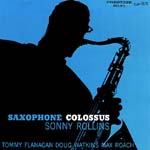 Saxophone
Colossus
Saxophone
Colossus
Prestige
Records
I had the
great good fortune to interview Sonny Rollins in the early 1990s,
shortly after the death of Miles Davis and Art Blakey. He expressed his
respect and reverence for them and others who had passed on and said he
felt not only honored, but obliged to uphold the jazz tradition in their
memory. It is amazing to me that he remains just as dedicated and
passionate about his music in 2010 as he did then and at the dawn of his
career in the early 1950s. In the course of his musical mission, Rollins
has recreated himself many times, most famously during a sabbatical of a
couple of years in the 1960s. There are so many great Rollins
recordings, it is tempting to recommend a boxed set, but I will go with
“Saxophone Colossus” from 1956 because it contains the saxophonist’s
great originals “St. Thomas,” “Strode Rode,” and “Blue Seven.” This
early example of Rollins at his most imaginative and technically
challenging also features Tommy Flanagan on piano, Doug Watkins on bass
and Max Roach on drums.
OSCAR PETERSON TRIO
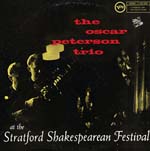 At
the Stratford Shakespearean Festival
At
the Stratford Shakespearean Festival
Verve
Records
It is
difficult to go wrong with any of Oscar Peterson’s many recordings
(Amazon lists 376 separate titles), released primarily on Mercury,
Verve, Pablo and Telarc from 1950 to 2007, the year of his death. His
staying power and talent were as prodigious as his girth. I recommend
1956’s “At the Stratford Shakespearean Festival” because it is the
pinnacle of the early Peterson trio that also featured guitarist Herb
Ellis and bassist Ray Brown. It captures them in thrilling live
performances of “Falling in Love with Love,” “Swinging on a Star,” “How
High the Moon,” “52nd Street Theme” and others, plus two
bonus tracks on the expanded 75-minute CD. This drummerless threesome
was together for about five years before Ellis left and Peterson added
drummer Ed Thigpen, so it documents a very significant period in
Peterson’s career. I also recommend it because it is an essential that
my own collection lacked for too many years.
ART BLAKEY AND THE JAZZ MESSENGERS
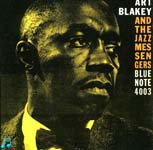 Moanin’
Moanin’
Blue
Note Records
The many
editions of Blakey’s Jazz Messengers—from the 1950s through the
1980s—produced some of the most memorable and historic hard-bop
recordings of all time, but 1958’s classic “Moanin’” must take the prize
for both outstanding compositions and exemplary musicianship. The lineup
was undoubtedly one of the best, with tenor saxophonist Benny Golson,
trumpeter Lee Morgan, pianist Bobby Timmons, and bassist Jymie Merritt.
Since this recording, the title track by Timmons, and Golson’s “Along
Came Betty” and “Blues March” have become jazz standards. The
seven-and-a-half-minute “Drum Thunder Suite” is palpable evidence of
Blakey’s mastery of his instrument, and even “Come Rain or Come Shine”
gets a bold new arrangement. “Moanin’” is the apogee of the group sound,
with all the individual talent, empathy and compatibility that
implies.
J.J. JOHNSON
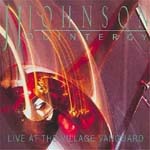 Quintergy
Quintergy
Antilles
Records
J.J.
Johnson’s early ‘50s recordings on Prestige and Blue Note are worthy of
mention as the first examples of his breakthrough sound on trombone,
both on ballads and bebop flag-wavers, and his many two-trombone
collaborations with Kai Winding are interesting, but I offer “Quintergy”
as the quintessential live recording of his later years and proof
positive that Johnson remained relevant and even revelatory. He was 64
when it was recorded at the Village Vanguard in 1988. Accompanied by
saxophonist Ralph Moore, pianist Stanley Cowell, bassist Rufus Reid and
drummer Victor Lewis, the 68-minute set represents the traditional bop
quintet’s state of the art, with excellent renditions of “Blue Bossa,”
“You’ve Changed” and Johnson’s own contribution to the jazz standard
songbook, the beautiful “Lament.” Also recommended is the CD “Standards:
Live at the Village,” taken from the same sessions and released
contemporaneously.
GRANT GREEN
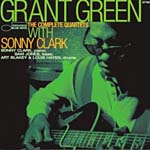 The
Complete Quartets with Sonny Clark
The
Complete Quartets with Sonny Clark
Blue
Note Records
A St. Louis
native who only moved to New York City in 1960 and died in 1979, Green
appeared on an amazing number of recordings in less then 20 years,
usually accompanying such notables as Jack McDuff, Lou Donaldson,
Stanley Turrentine, Hank Mobley, Jimmy Smith, Herbie Hancock and Lee
Morgan. He also fronted more than two dozen of his own recordings,
mostly on Blue Note. Green’s profusion of ideas is best appreciated on
longer tracks, making “The Complete Quartets with Sonny Clark” an easy
choice. This two-CD set includes 19 tunes totaling more than two hours
of brilliant interplay among Green, pianist Clark, bassist Sam Jones and
either Art Blakey or Louis Hayes on drums. Recorded during a five-week
period in 1962, the sessions were shelved until 1980, and then released
only in abbreviated form in the U.S. and Japan. This 1997 Blue Note
package is a feast for Green fans and newcomers alike, with the
guitarist soaring through extended takes on “Airegin,” “It Ain’t
Necessarily So,” “The Song Is You,” “Gooden’s Corner,” “Hip Funk,” and
“My Favorite Things.”
